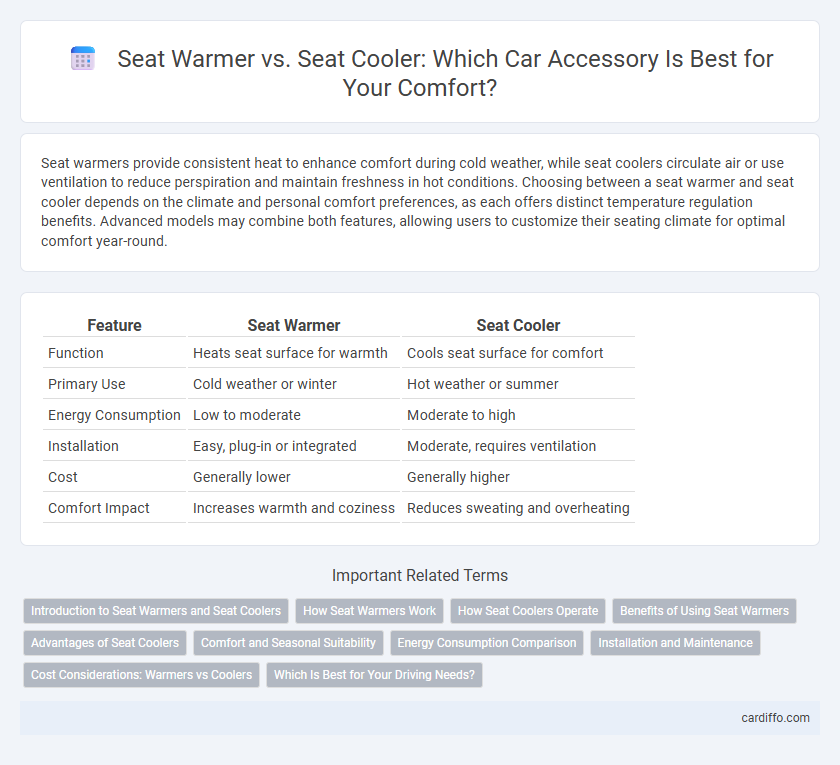Seat warmers provide consistent heat to enhance comfort during cold weather, while seat coolers circulate air or use ventilation to reduce perspiration and maintain freshness in hot conditions. Choosing between a seat warmer and seat cooler depends on the climate and personal comfort preferences, as each offers distinct temperature regulation benefits. Advanced models may combine both features, allowing users to customize their seating climate for optimal comfort year-round.
Table of Comparison
| Feature | Seat Warmer | Seat Cooler |
|---|---|---|
| Function | Heats seat surface for warmth | Cools seat surface for comfort |
| Primary Use | Cold weather or winter | Hot weather or summer |
| Energy Consumption | Low to moderate | Moderate to high |
| Installation | Easy, plug-in or integrated | Moderate, requires ventilation |
| Cost | Generally lower | Generally higher |
| Comfort Impact | Increases warmth and coziness | Reduces sweating and overheating |
Introduction to Seat Warmers and Seat Coolers
Seat warmers use embedded heating elements to provide soothing warmth during cold weather, enhancing driver and passenger comfort. Seat coolers employ ventilation systems that circulate air through perforated upholstery, reducing heat and moisture buildup in hot climates. Both accessories improve the driving experience by addressing temperature control directly at the seating surface.
How Seat Warmers Work
Seat warmers use built-in electric heating elements integrated into the seat cushions to generate heat, providing a comfortable and cozy experience during cold weather. Sensors regulate the temperature, ensuring consistent warmth without overheating, while the system is powered by the vehicle's electrical system. This technology enhances comfort by targeting the seat area directly, making it more efficient than heating the entire cabin.
How Seat Coolers Operate
Seat coolers operate by circulating cooled air or employing thermoelectric cooling elements embedded within the seat cushions, effectively reducing surface temperature to enhance passenger comfort in hot weather conditions. These systems use integrated fans or refrigeration technology to dissipate heat away from the occupant, contrasting with seat warmers that utilize resistive heating elements to generate warmth. Advanced seat coolers often include adjustable settings for personalized climate control and can be seamlessly integrated into vehicle infotainment systems for user-friendly operation.
Benefits of Using Seat Warmers
Seat warmers provide enhanced comfort by quickly heating car seats during cold weather, improving overall driving experience and reducing muscle stiffness. By increasing blood circulation, they help alleviate back pain and promote relaxation on longer trips. Energy-efficient designs ensure minimal impact on vehicle battery life while maximizing warmth for passenger comfort.
Advantages of Seat Coolers
Seat coolers provide enhanced comfort by reducing seat temperature, preventing discomfort and sweating during hot weather. They help maintain alertness and reduce fatigue by keeping drivers and passengers cool, contributing to safer driving conditions. Seat coolers also protect seat materials from heat-related damage, extending the lifespan and appearance of car interiors.
Comfort and Seasonal Suitability
Seat warmers provide optimal comfort during cold seasons by quickly generating heat to keep occupants cozy, enhancing overall driving experience in winter. Seat coolers circulate air or use ventilation systems to reduce heat buildup, offering relief and improved comfort in hot weather conditions. Both accessories significantly improve in-car comfort, with seat warmers suited for colder climates and seat coolers ideal for warm, summer months.
Energy Consumption Comparison
Seat warmers typically consume more energy than seat coolers due to the electrical resistance heating elements that require continuous power to generate heat. In contrast, seat coolers use energy-efficient fans or thermoelectric cooling modules, which generally draw less current while maintaining comfort. Comparing energy consumption data, seat warmers can use up to 50 watts per hour, whereas seat coolers often operate around 10 to 20 watts per hour, making coolers more energy-efficient in most vehicle accessory setups.
Installation and Maintenance
Seat warmer and seat cooler accessories require professional installation to ensure proper integration with a vehicle's electrical system, often involving wiring under the seats. Maintenance of seat warmers typically includes checking heating elements and connectors for wear, while seat coolers demand regular inspection of cooling fans and ventilation pathways to maintain efficiency. Both systems benefit from routine cleaning and prompt attention to any electrical issues to prolong lifespan and performance.
Cost Considerations: Warmers vs Coolers
Seat warmers typically incur lower initial costs compared to seat coolers due to simpler heating elements and less complex installation requirements. Energy consumption for seat warmers is generally modest, but seat coolers demand more power, potentially increasing operational expenses. Maintenance costs for coolers can be higher because of mechanical components like fans or thermoelectric modules, whereas warmers involve minimal upkeep.
Which Is Best for Your Driving Needs?
Seat warmers provide targeted heat for cold weather, enhancing comfort during winter drives by quickly warming up car seats. Seat coolers circulate air or use ventilation to reduce seat temperature, ideal for hot climates or long summer trips to prevent sweating and discomfort. Choosing between a seat warmer and cooler depends on your regional climate and personal comfort preferences for optimal driving experience.
Seat Warmer vs Seat Cooler Infographic

 cardiffo.com
cardiffo.com